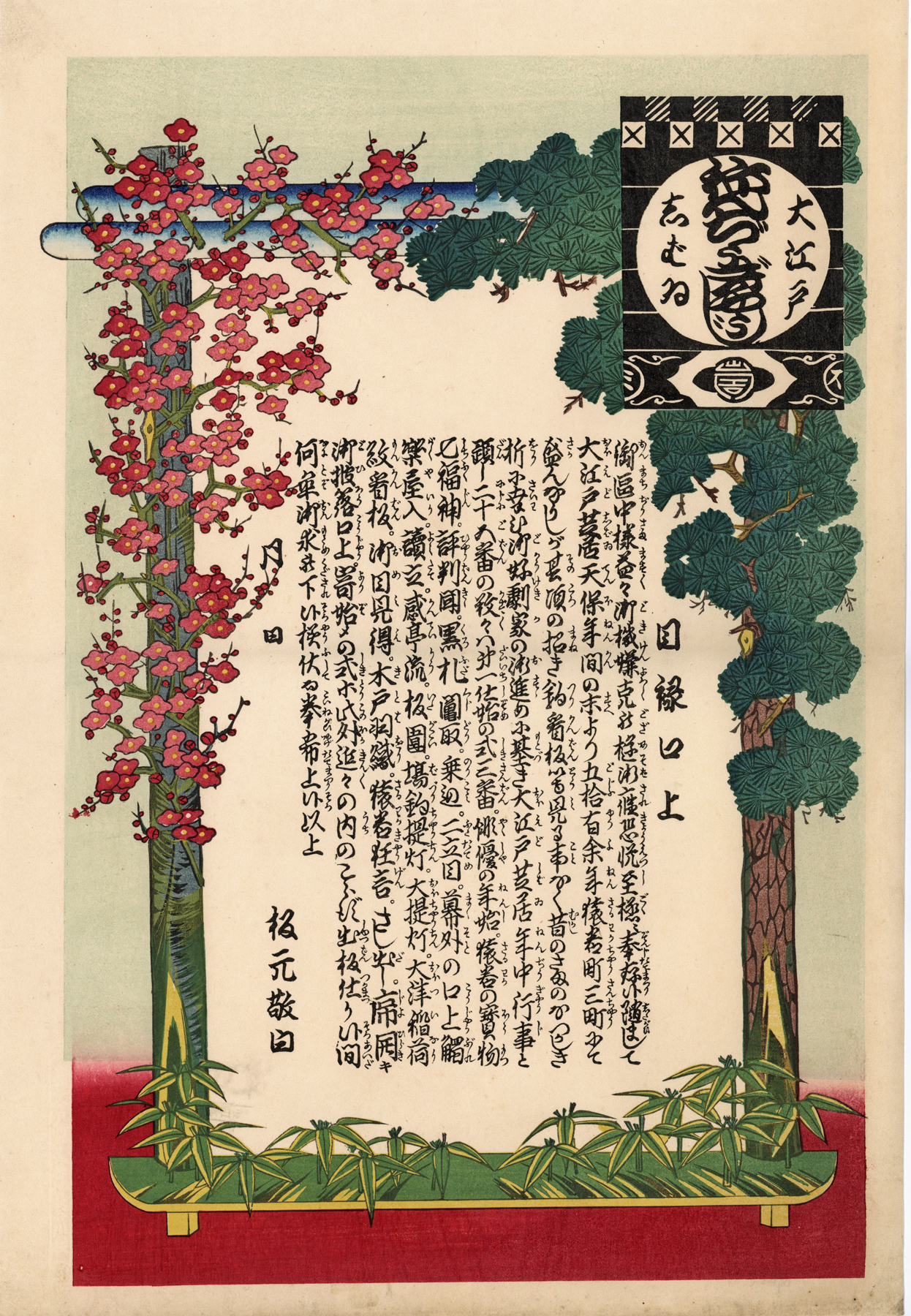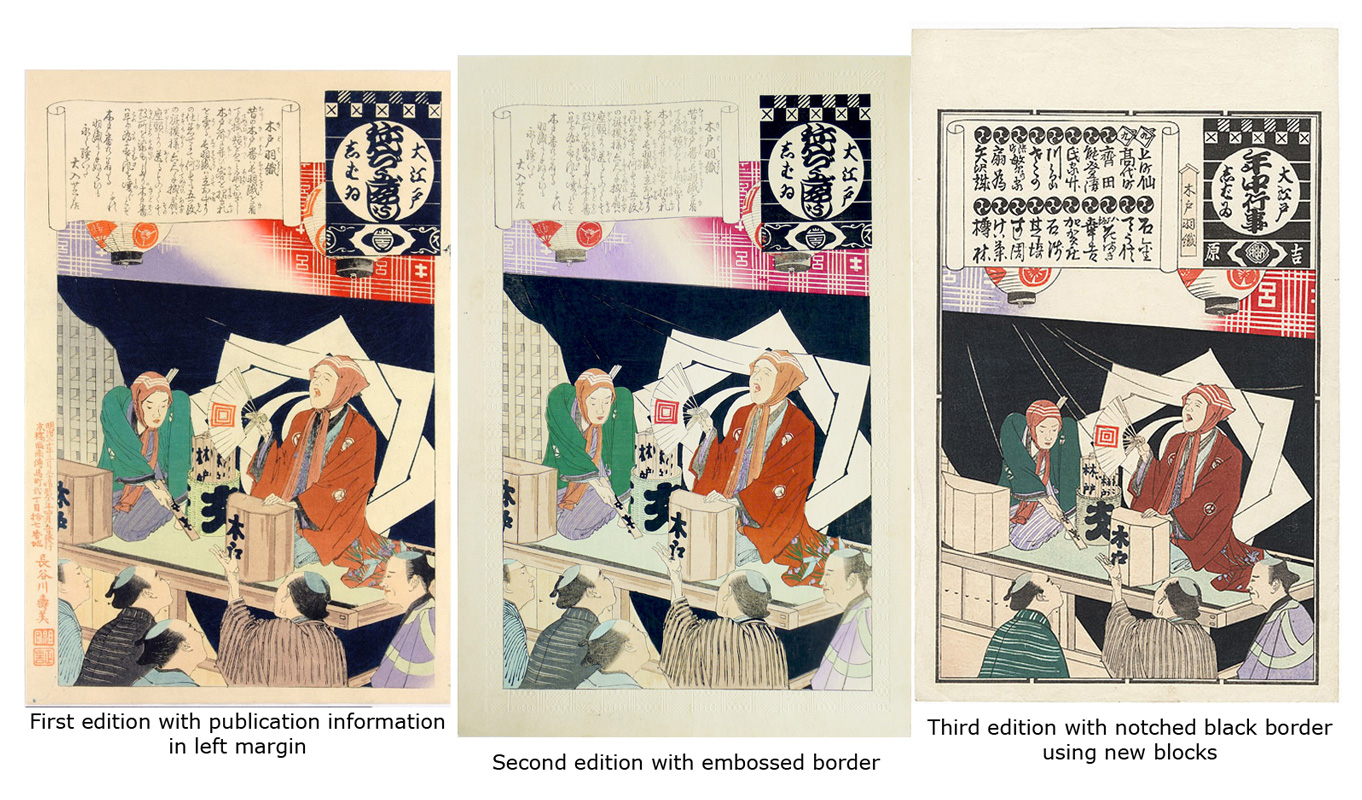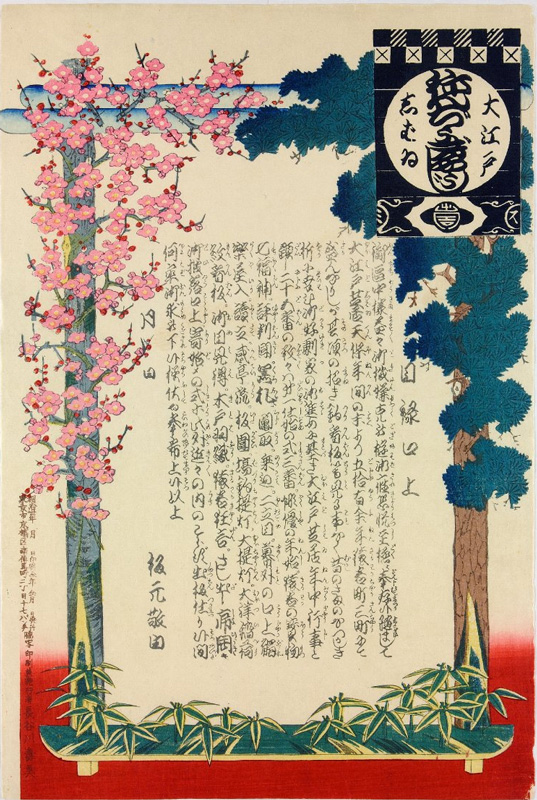About This Print
Source: The British Museum http://www.britishmuseum.org/research/search_the_collection_database/search_object_details.aspx?objectid=781197&partid=1&searchText=adachi+ginko&fromADBC=ad&toADBC=ad&numpages=10&orig=%2fresearch%2fsearch_the_collection_database.aspx¤tPage=2The title page providing a list of all twenty-five prints in the series Annual Events of the Edo Theater, originally published in 1897 by Hasegawa Sumi 長谷川寿美 (長谷川スミ). The list of prints is provided in the form of a stage speech by the publisher. The text is surrounded by the auspicious symbols of pine, bamboo and red plum.
About This Series
Source: Tokyo Metropolitan Library http://www.library.metro.tokyo.jp/Portals/0/edo/tokyo_library/english/modal/print.html?d=20; ARC http://www.arc.ritsumei.ac.jp/lib/vm/kabuki2015_e/2015/11/oedo-shibai-nenjyu-gyoji.html and from personal observation.Ōedo Shibai Nenjū Gyōji (Annual Events of the Edo Theater) drawn by Adachi Ginko [with two prints, Yomitate (Public Reading) and Saruwaka Kyōgen (IHL Cat. #2015), contributed by Torii Kiyosada (1844-1901)] is a set of twenty-six prints (including an index/prologue page), depicting the manners and customs relating to Kabuki plays/theaters in the Saruwaka-chō, the Kabuki theater district which flourished until 1867, the first year of the Meiji Era. The Ritsumeikan Art Research Center posits that this series was issued in response to the public's "remarkable nostalgia for [the] Edo period, the 'Great Tokugawa Epoch'." It goes on to say that this series is a continuation of the many earlier Kabuki theater guidebooks which "introduce[d] not only about things on a stage but also properties, organization of theatres and backstage."
Three Editions
At least three editions of this series were released. One edition, likely the first edition, contains the publisher's name, Hasegawa Sumi, and associated publishing and printing information along the left margin. This first edition, with the publishing information, is often found bound into volumes, with the margins of the prints trimmed back. My guess is that these bound volumes were created by the publisher. Another edition, likely a second edition, uses an embossed border around the entire image which is not present on the earlier edition. Generally these second edition prints have wider margins than the first edition. It is possible that these second edition prints were sold by subscription. A third edition, which appears to be printed from new blocks, as differences in composition in each print can be seen, is a less elaborate printing than the earlier editions. Interestingly, this later edition uses the convention called komochiki of a thick notched line and thin black line framing the subjects, a popular Edo textile pattern thought to reflect iki taste (Edo chic). Use of this type of framing is associated with kōkanfuda, a type of votive offering print. (See IHL Cat. #1686 A Set of Three Nōsatsu Kōkanfuda - Fūjin the Wind God, Raijin the Thunder God, Calligraphic Cover Sheet for more information about kōkanfuda.)
At least three editions of this series were released. One edition, likely the first edition, contains the publisher's name, Hasegawa Sumi, and associated publishing and printing information along the left margin. This first edition, with the publishing information, is often found bound into volumes, with the margins of the prints trimmed back. My guess is that these bound volumes were created by the publisher. Another edition, likely a second edition, uses an embossed border around the entire image which is not present on the earlier edition. Generally these second edition prints have wider margins than the first edition. It is possible that these second edition prints were sold by subscription. A third edition, which appears to be printed from new blocks, as differences in composition in each print can be seen, is a less elaborate printing than the earlier editions. Interestingly, this later edition uses the convention called komochiki of a thick notched line and thin black line framing the subjects, a popular Edo textile pattern thought to reflect iki taste (Edo chic). Use of this type of framing is associated with kōkanfuda, a type of votive offering print. (See IHL Cat. #1686 A Set of Three Nōsatsu Kōkanfuda - Fūjin the Wind God, Raijin the Thunder God, Calligraphic Cover Sheet for more information about kōkanfuda.)
Summary of Differences Between the Three Editions
1. First edition prints contain the publishing and printing information, including dates, along the left margin. In the later edition of prints only the Index/Prologue print contains any publishing information, with the publishing house 長谷川 板 (Hasegawa han), proceeded by the publisher's address embossed in the lower left corner. No date is given on this print or any other later edition prints.
2. Most first edition prints contain the artist's signature and/or seal. Later editions do not carry the artist's signature or seal.
3. Second edition prints contain an approximately 1/2" wide embossed border around the entire image area not present on the first edition.
4. Some second edition prints may have had the original blocks reworked.
5. Third edition prints were printed from new blocks and all have a thick notched line and thin black line framing the subjects.
Earlier Edition of This Print
Source: The British Museum 1983,0523,0.3.1
Note the presence of the publishing information in the print's left margin that is not present
on this collection's print which has the publisher's name and address embossed in its lower left corner
The Complete Series (first edition)
click on image to enlarge
Translations of the prints, appearing above each print, have been taken from the British Museum's website. The entire series can be seen at http://www.britishmuseum.org/system_pages/beta_collection_introduction/beta_collection_search_results.aspx?searchText=Annual+Events+of+the+Edo
Translations of the prints, appearing above each print, have been taken from the British Museum's website. The entire series can be seen at http://www.britishmuseum.org/system_pages/beta_collection_introduction/beta_collection_search_results.aspx?searchText=Annual+Events+of+the+Edo
Print Details
| IHL Catalog | #1308 |
| Title or Description | Mokoroku kōjō 目録口上 (Prologue, Title sheet/table of contents) |
| Series | Annual Events of the Edo Theatre (Ō-Edo shibai nenjū-gyōji 大江戸しばゐねんぢうぎやうじ) |
| Artist | Adachi Ginkō (active 1874 – 1897) |
| Signature | unsigned |
| Seal of the Artist | no seal |
| Publication Date | 1897 (Meiji 30) note: The original publication date of the first edition is 1897. The publication date of this collection's print, a second edition, is unknown. |
| Publisher | Hasegawa Sumi 長谷川寿美 embossed seal reading 浅草今戸町五十九番地長谷川板 Asakusa imadochō 59-banchi Hasegawa han [Marks: seal not shown; publisher ref. 102] (click on image to enlarge) |
| Carver | unknown |
| Printer | |
| Impression | excellent |
| Colors | excellent |
| Condition | excellent - full size; not backed; soiling along bottom margin; diaganol folds both sides of bottom margin |
| Genre | ukiyo-e; yakusha-e |
| Miscellaneous | |
| Format | vertical oban |
| H x W Paper | 16 x 10 3/16 in. (40.6 x 25.6 cm) |
| H x W Image | 14 7/8 x 9 7/8 in. (37.8 x 25.1 cm) |
| Literature | |
| Collections This Print | British Museum 1983,0523,0.3.1; Waseda University Cultural Resource Database 201-0692 and 201-0203; National Diet Library 寄別8-4-2-1; Tokyo Metropolitan Library 577-10-1; Art Research Center, Ritsumeikan University AcNo.arcUP2039 |
8/5/2021
2/14/20206/5/2018





